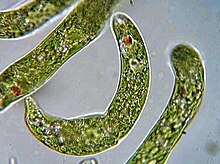Euglena
| Euglena | |
|---|---|
 |
|
| Scientific classification | |
| Domain: | Eukaryota |
| (unranked): | Excavata |
| Division: | Euglenozoa |
| Class: | Euglenoidea |
| Order: | Euglenales |
| Family: | Euglenaceae |
| Genus: |
Euglena Ehrenberg, 1830 |
Euglena is a genus of single-celled flagellate Eukaryotes. It is the best known and most widely studied member of the class Euglenoidea, a diverse group containing some 54 genera and at least 800 species. Species of Euglena are found in fresh and salt waters. They are often abundant in quiet inland waters where they may bloom in numbers sufficient to color the surface of ponds and ditches green (E. viridis) or red (E. sanguinea).
The species Euglena gracilis has been used extensively in the laboratory as a model organism.
Most species of Euglena have photosynthesizing chloroplasts within the body of the cell, which enable them to feed by autotrophy, like plants. However, they can also take nourishment heterotrophically, like animals. Since Euglena have features of both animals and plants, early taxonomists, working within the Linnaean three-kingdom system of biological classification, found them difficult to classify. It was the question of where to put such "unclassifiable" creatures that prompted Ernst Haeckel to add a third kingdom to the Animale and Vegetabile of Linnaeus: the Kingdom Protista.
When feeding as a heterotroph, Euglena takes in nutrients by osmotrophy, and can survive without light on a diet of organic matter, such as beef extract, peptone, acetate, ethanol or carbohydrates. When there is sufficient sunlight for it to feed by phototrophy, it uses chloroplasts containing the pigments chlorophyll a and chlorophyll b to produce sugars by photosynthesis.Euglena's chloroplasts are surrounded by three membranes, while those of plants and the green algae (among which earlier taxonomists often placed Euglena) have only two membranes. This fact has been taken as morphological evidence that Euglena's chloroplasts evolved from a eukaryotic green alga. Thus, the intriguing similarities between Euglena and the plants would have arisen not because of kinship but because of a secondary endosymbiosis. Molecular phylogenetic analysis has lent support to this hypothesis, and it is now generally accepted.
...
Wikipedia
